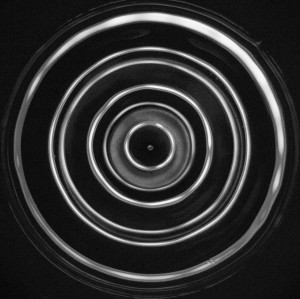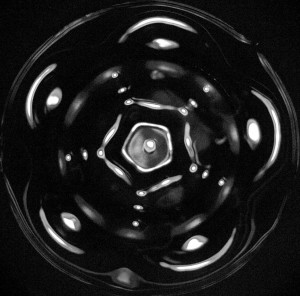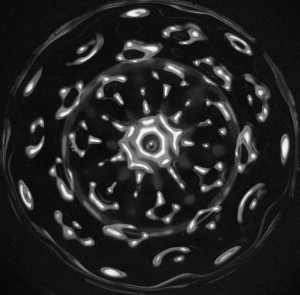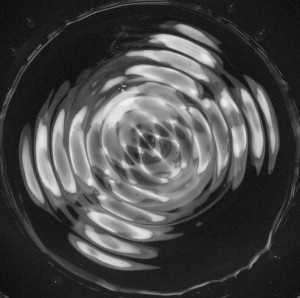 Stuart Davidson of the University of Wales included an exhibition of cymatics images he created and photographed in his studies at the school recently.
Stuart Davidson of the University of Wales included an exhibition of cymatics images he created and photographed in his studies at the school recently.
He sends these photos along from his final project, and this is what he has to say about making the cymatics images:
“The project was mainly about discovering how to create my own cymatic set-up and then choosing an effective way to capture the patterns that came from it. From extensive research and being more observant during day to day life, this project is being to lead me to believe that light is just an exstention from sound. Therefore we are really looking at sound, and potentially all we see is an immense/dense amount of cymatics. The framerate of humans and the amount of sound we are able to hear and interpret restricts us from being able to notice the make-up of the world around us.” – Stuart Davidson
Please enjoy these cymatics images, and remember they are the proprietary work of an artist, so please don’t “steal” them. If you would like to request permission to use one on your site you may contact the artist.





P.S. If you are currently working on or have finished a cymatics project as part of your University studies, we would love to hear about it here at the Journal! Leave a comment below if you would like to see your project (or work in progress) showcased here too…
{ 6 comments… read them below or add one }
Congratulations to Stuart Davidson for his achievements! Great images! May they serve as an inspiration for other students to explore the field of Cymatics.
Cymatics- on its way to becoming a household word!
Reply
http://www.parkerlogandennison.com/act.html
This was one installation of five in my senior art exhibit that emphasized choice and the infinite. The Cymatics piece was title Act, as it reminds us that our choices take shape through our energy and movement.
Two hemispheres were constructed of recycled propane tank ends 3′ in diameter, rested under a tree and were activated as a passerby might swing a hanging wooden clapper into the bowls to create a gong effect and activate a beautiful unique visual of the sound of the form that it present.
Check out the 5Diminsion Infinity Project to get a better idea of the context which this piece plays. It is a physical model of Active-Contemplation…
BTW you might also enjoy ‘Listen’. Hear the sounds at the bottom of its page. In approaching the giant windchimes one could feel the sound before they could hearing it.
I hope you enjoy the work.
Logan Dennison
Reply
Thanks Stuart beautiful images. I wonder if you would be interested in talking. I am working in a meditative way with sound and what you said about sound and light is what I have discovered through personal research. I am opening a centre/ gallery for sound and silence and am seeking art images for the walls. I live in Wales ( Cardigan) Could we be in contact.
Reply
Hello Julie, I’d be interested to help out. The centre/gallery you are opening sounds exciting!
You can contact me via: smdavison@hotmail.co.uk
Stuart
Reply
I saw this post and it reminded me of a similar project I did in college in 1983 as an honors thesis. Recently, I wrote this description to a young student interested in the project:
I had a drum head (actually three of them, different shapes), and I put a reflective mylar coating on it, then I put a speaker coil underneath attached to the head in a particular place that I calculated to be the best spot. Then I composed some computer music that went to that speaker coil as well as to actual speakers. I reflected colored light off of the drum head and onto a big screen.
The result was that we could see how the drum heads were vibrating, and they vibrated very differently according to the pitch (actually the frequency) of the music. The drum heads responded to some pitches very strongly and hardly at all to other pitches (like C-sharp or A-flat, but not exactly those). I did a whole research project to explain and control which pitches the drumheads would respond to (with Bessel functions, etc.), and they weren’t all on the regular western musical scale (C, D, E, F, etc.) of course, which was OK since I was using a computer to make the music and I could use any pitches I wanted to, whether or not they were on the western scale.
The patterns I got with light are exactly the opposite you would get with sugar on the metal plate in a sense. What happens when you reflect light off of vibrating surfaces is that the light is strongest from the points on the surface that are moving up and down the most. That’s because the parts that aren’t moving up and down the most (we call them the “nodes”) are actually twisting (rotating) and spreading the light far and wide. The points on the surface that are moving up and down the most are staying more flat, so they can keep reflecting light as they vibrate. Sorry–this is a bit hard to explain without doing any drawings.
The situation when you put grains of salt or sugar or something on the surface, as you’re doing, is different. What they do is accumulate along the nodes, meaning along the lines and in the spots where there is the least up and down movement. That’s because the grains bounce off of the spots with the greatest up and down movement, so they tend to accumulate where there is the least up and down movement (exactly what we call the nodes).
When you play music that excites the surface (the plate), meaning causing it to vibrate–move up and down–you’ll notice some pitches will stimulate the plate to vibrate much more and thus produce clearer, stronger patterns in the sugar. That’s because every surface has it’s own “normal” (like favorite) “modes of vibration.” There are particular frequencies that the plate (or surface) responds better to and for each one of those frequencies, there is a different pattern of vibration.
But when you play recorded music, you’re actually playing many different frequencies all at the same time. So you’re getting a mix of patterns. If you wanted to see what the basic set of patterns is, you’d have to play only one frequency at a time (a sine wave, it’s called) onto the surface. You can do that if you have the electronic instruments that can do it. Then you could sweep up the whole range of frequencies to discover the full set of “normal modes of vibration.”
Anyway, it’s fun to just play music and see what patterns form. You know now that the patterns of sugar that you see are the still-est places on the plate. That’s why all the sugar particles go there.
I hope this explanation was helpful. Good luck with your projects, and let me know if you’d like me to clarify any of this.
Reply
Jodina Meehan Reply:
March 27th, 2015 at 10:39 am
Thank you for sharing your work! And you were working on this in 1983! Have you checked out the school of cymatics yet? http://www.schoolofcymatics.coom (you may like to have a page over there, you can see others work and share your experience too). Best wishes, -Jodina
Reply
Hola aca esta el link para ver mi experiencia perssonal con la creacion de una maquina para ver los sonidos con diseño cromatico.
https://www.youtube.com/watch?v=-1kgTzR6SCA
Atte Oscar Hernan Guzman
Neuquen Argentina
Reply